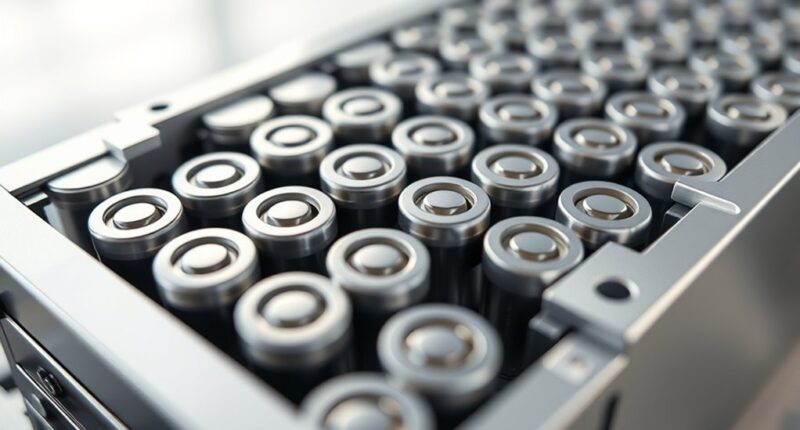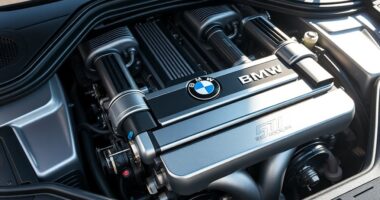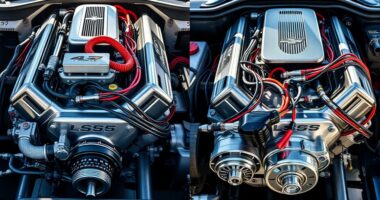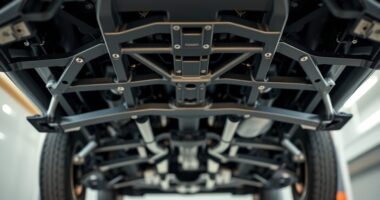Tesla started with 18650 cells, focusing on refining manufacturing processes for efficiency, safety, and quality. Over time, they shifted to larger, more advanced cells with higher energy density, enabling longer range and faster charging. Now, Tesla integrates these cells into structural battery packs, enhancing safety, reducing weight, and streamlining production. This evolution considerably improves vehicle performance and reliability—something you’ll discover as you explore how Tesla continually innovates in battery technology.
Key Takeaways
- Tesla transitioned from using 18650 cells to larger, more energy-dense cells like 2170 and 4680 for improved efficiency.
- The shift to structural battery packs integrates cells into a single, rigid structure for enhanced safety and weight reduction.
- Advanced manufacturing processes and automation enabled scalable production of newer cell formats.
- Innovations in electrode and separator materials increased energy density and charging speeds over time.
- Structural packs simplify assembly, reduce parts, and improve vehicle safety and rigidity.
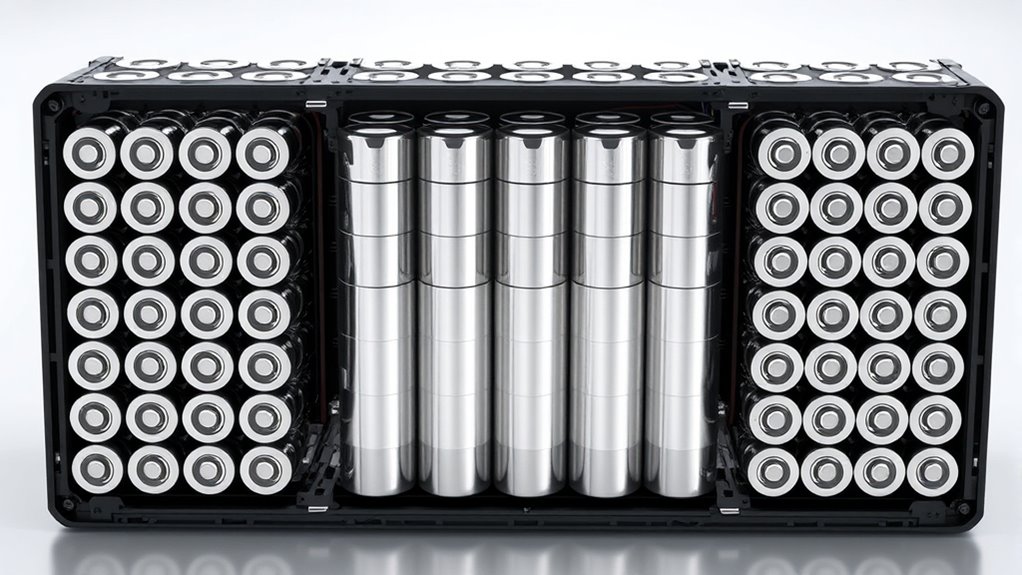
Tesla’s focus on refining cell manufacturing processes also plays a major role in their battery evolution. When you consider the journey of a battery cell from raw materials to finished product, Tesla has perfected each step for efficiency and quality. The company’s gigafactories utilize advanced manufacturing techniques, such as automated assembly lines and precision coating processes, to produce uniform, high-quality cells at scale. These improvements reduce variability and defects, ensuring each cell performs reliably. Additionally, Tesla’s innovation in electrode composition and separator materials contributes to higher energy density, meaning your vehicle can store more energy in a smaller space. This translates into longer driving ranges and faster charging capabilities, enhancing your overall driving experience. Tesla’s ongoing research into battery safety**** further ensures that your vehicle remains secure under various operating conditions.
Frequently Asked Questions
What Are the Main Advantages of Tesla’S Structural Battery Packs?
You’ll find Tesla’s structural battery packs offer key advantages, like significant battery weight reduction, which boosts overall vehicle efficiency and range. They also enhance manufacturing efficiency by integrating structural elements directly into the pack, simplifying assembly and reducing costs. This design improves safety and durability while streamlining production processes, making Tesla’s vehicles more reliable and cost-effective for you.
How Does Tesla Improve Battery Recycling and Sustainability?
You might think Tesla’s focus on battery reuse and eco-friendly materials is just marketing, but they genuinely aim to improve sustainability. They design batteries for easier recycling, reducing waste and extending battery life. Using eco-friendly materials helps lower environmental impact. Tesla also develops programs to reclaim and repurpose old batteries, promoting circularity. This commitment guarantees you’re supporting a cleaner future, making electric vehicles even more sustainable and environmentally friendly.
What Are the Future Innovations Planned for Tesla’s Battery Technology?
Tesla plans to revolutionize battery tech with solid state batteries, offering greater energy density and safety. You’ll see ultra fast charging become standard, letting you recharge your vehicle in minutes. These innovations aim to extend battery life, improve performance, and reduce costs. As Tesla pushes forward, you can expect smarter, more sustainable energy solutions that make electric driving even more convenient and efficient for your everyday needs.
How Does Battery Design Impact Vehicle Safety and Crashworthiness?
Think of your car’s battery as the backbone of safety; its design directly influences crashworthiness. Good thermal management keeps temperatures in check, preventing fires or failures. Manufacturing safety guarantees quality and reduces defects that could cause hazards. A well-designed battery acts like a sturdy shield, absorbing impacts and protecting you during a crash. This careful engineering makes your vehicle safer and more reliable, giving you peace of mind on every drive.
What Challenges Does Tesla Face in Scaling Battery Production Globally?
You face challenges in scaling Tesla’s battery production globally, mainly due to supply chain disruptions and regulatory hurdles. Securing raw materials like lithium and cobalt can be difficult, causing delays and increased costs. Additionally, maneuvering different countries’ safety standards and environmental regulations demands significant resources. These issues may slow expansion plans, but with strategic sourcing and compliance efforts, you can mitigate some of these obstacles and continue growing your battery manufacturing capabilities.
Conclusion
As you watch Tesla’s battery journey unfold, it’s like witnessing a master sculptor refining their craft. From the humble 18650 cells to sleek structural packs, Tesla continuously hones its innovation, carving out a brighter, more efficient future. Each advancement is a chisel stroke, shaping the landscape of clean energy. So, stay tuned—you’re riding the wave of a revolution, where batteries are the heartbeat of a sustainable world in motion.
